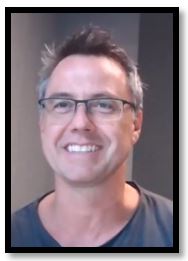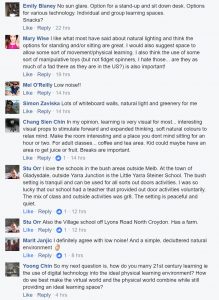ClarkeHopkinsClarke Architects –
Wayne Stephens (Partner)
My Education Group –
Tom Shugg (Co-Founder)
Sam Dean (Co-Founder)
Lottie Dowling (Chinese Curriculum Coordinator)
Mike (Chinese Tutor)
Elise (Chinese Tutor)
Mernda Primary School –
Yoong Chin (Leading Teacher)
Luke Bates (ICT Technician)
Mia Thallas (Year 5 Student)
Kelly Chang (Year 5 Student)
Creating and developing an informal Creative Coffee Morning was a really exciting project for me. This opportunity encouraged me to step outside of what I have always done as an educator, and actually stop and take the time to listen to what people from non education backgrounds consider to be the ultimate 21st century learning environment.
When organising this coffee morning as a ‘Designing Spaces for Learning’ task, we were encouraged to step outside of our comfort zone and bring known and unknown people together for an informal discussion around designing learning spaces. At this time I chose to research who the architectural designers were that made the buildings in which I currently work in. These schools are known as PPP (Public Private Partnership Project) schools, I made a cold call to Clarke Hopkins Clarke Architects to see if I could organise one of these cutting edge designers to attend the Coffee Morning, to my excitement, an architect from the firm agreed to come out and meet with us.
I then contacted the founders of (MEG) My Education Group (who have a partnership with our school) and invited them to come along to discuss learning spaces with a specific focus on improving the gap between the physical and virtual learning environment. The founders of MEG, Tom Shugg and Sam Dean were invested in the idea of improving student engagement and learning for their online LOTE program they they also invited along their program developer Lottie Dowling, and two of their Chinese tutors Mike and Elisa (who were located in Beijing) to Zoom into our meeting. Taking into consideration other stakeholders of this learning environment, the school technician Luke Bates and two students in the program Kelly and Mia also attended to share their thoughts on learning spaces. With all meeting invitations out, I then created a list of questions that I hoped were open ended enough to stimulate conversation and discussion and then crossed my fingers for a successful meeting.
There were some challenges that I came across when the day of the Coffee Morning came about. The first one being that the architect who was coming up to the school had fallen ill and could no longer make the session. Luckily the partner of Clarke Hopkins Clarke, Wayne Stephens, kindly agreed to join our meeting via an online platform to share and discuss his passions for designing educational learning spaces. Another such challenge was the time differences between China and Australia and the time of student classes and breaks. This posed a logistical problem to get all stakeholders in the same place and at the same time. A huge motivator contributing to the success of this creative was the support of everyone involved and the joint interest in having the open discussions with the intent to generate deeper thinking and reflections.
After conducting the Creative Coffee Morning, I reflected on the discussion and felt that I had created an environment that was still to restricted in order to find out what people really want in a Learning Space, therefore I reached out and posed some questions on social media to gauge what my community of friends and non-educators thought about the design of effective learning spaces also challenged my understandings of what people want in their learning environments. Their responses allowed me to reflect and consider feedback from people who were truly out of the educational environment.
https://www.facebook.com/yoong.chin.3/posts/10159207664400104
The main points that I personally took away from this Creative Coffee Morning and the Online Forum were the following:
- Just because it is the way it is now, doesn’t meant that it always needs to be that way.
- People are willing and able to discuss and talk if we only stop the day to day grind long enough and allow for these conversations to happen.
- It is difficult to provide the ‘ultimate’ environment for learning in any single one learning space. These spaces can be designed for different purposes and the educator can fluidly use spaces to create effective learning environments depending on the task at hand.
- Many people (to my surprise) seek greenery and links to nature in their ideal learning space and there fore calming colours and inside/outside learning was of great importance.
- Digital technology infrastructures, while a strong consideration, was not as important to learners as noise control and the connection to nature.
- People like flexible spaces for their learning.
For further reading and investigation, some of the following sites have assisted my thought process and discovery in regards to current day education and catering for 21st century learners;
Melbourne University LEARN http://research.unimelb.edu.au/learnetwork/home
TED for design wonks: Creative mornings offers coffee and a shot of inspiration https://www.wired.com/2012/06/creativemornings-conferences/
Tom Kelley: ‘Invite serendipity to your cafe and expect innovation’ http://www.wired.co.uk/article/tom-kelley
Questions to assist the Creative Coffee Morning: Mernda Primary School – General ideas for discussion-s8k5jb









